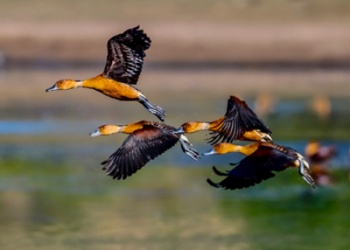- Dendrocygna bicolor
Identification
L. 18-21" (46-53 cm)
A long-legged, long-necked, goose-like duck.
- Body mainly tawny
- White stripe on side
- Dark wings
- White rump and undertail coverts
The name "fulvous" refers to its tawny color.
Distribution
Southern USA to Argentina; eastern Africa, Madagascar and southern Asia.
Resident coastal Texas and Louisiana, and southern Florida. Formerly in southern California but now extirpated there. Although Fulvous Whistling-Ducks in North America breed only in Texas, Louisiana, and Florida, they sometimes wander. Small flocks have turned up as far away as British Columbia and Nova Scotia.
Taxonomy
This is a monotypic species[1].
This species was formerly known as the "Fulvous Tree Duck."
Habitat
Freshwater lakes and reservoirs, rice fields, freshwater marshes, wet meadows, and lagoons.
Behaviour
Diet
These long-legged ducks do most of their feeding on land, eating green grass, seeds, and acorns.
Breeding
The 12-15 buff-white eggs are laid in a shallow cup of grass or a well-woven basket of reeds in a marsh. Sometimes several females lay in the same nest.
References
- Clements, J. F., T. S. Schulenberg, M. J. Iliff, S. M. Billerman, T. A. Fredericks, B. L. Sullivan, and C. L. Wood. 2019. The eBird/Clements Checklist of Birds of the World: v2019. Downloaded from http://www.birds.cornell.edu/clementschecklist/download/
Recommended Citation
- BirdForum Opus contributors. (2024) Fulvous Whistling Duck. In: BirdForum, the forum for wild birds and birding. Retrieved 21 December 2024 from https://www.birdforum.net/opus/Fulvous_Whistling_Duck
External Links
GSearch checked for 2020 platform.1






